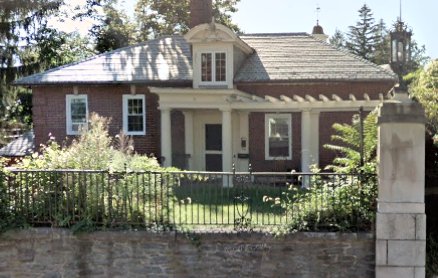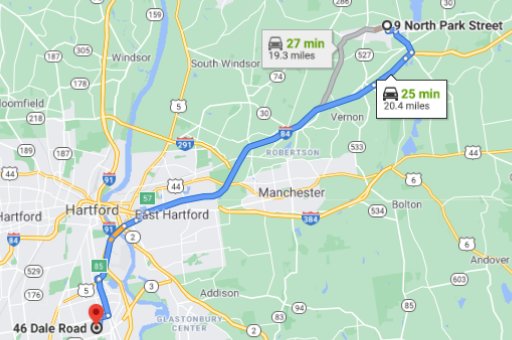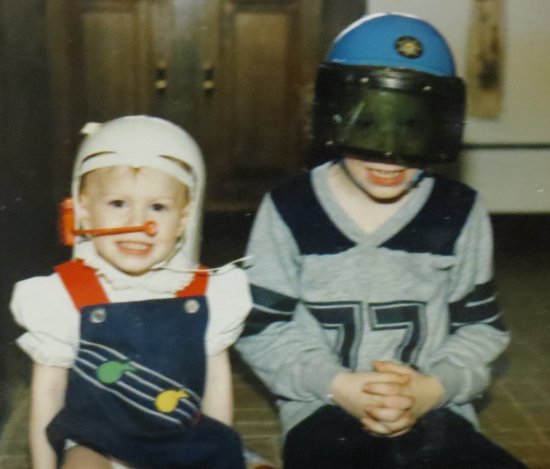Back in the Land of Steady Habits. Continue reading
By the fall of 1980 my dream of a life as a debate coach seemed unattainable. I enjoyed coaching as much as ever, but I could not visualize how I could make an enjoyable career of it. A few colleges hired someone just to coach debate, but these highly prized positions seldom turned over. Although I had a good record, I had no strong connections. Moreover, I had no idea how to find and obtain such a job.
There was not an abundance of potential coaching positions, and the vast majority of them were for someone with a PhD who would act as Director of Forensics and would also perform other roles in the speech department. This path did not appeal to me for at least four reasons:
- I would need to finish my PhD, which meant doing my dissertation. This did not appeal to me at all, for reasons that are described here.
- I could not see myself as a faculty member of a speech department. I had little or no respect for any of the speech professors that I had met, and I dreaded the prospect of dealing with departmental politics.
- I would be expected to research and publish. Nothing about the field of speech communication interested me enough to research.
- I would be expected to teach and serve on committees of MA and PhD candidates. I would almost certainly get stuck teaching the statistics class that every grad student hated. I probably also would be the guy on the committee who forced students to deal all of the problems with the design of their studies. I cannot seeing myself approving any approach that misused statistics or drew only patently obvious conclusions. I would not mind much if some people didn’t like me, but I did not want to be the ogre of the department.
There was one other factor. Sue and I had very little money by the end of 1980. I needed to start bringing in some bacon pretty quickly. I knew that I had a real talent for computer programming, and I really enjoyed bringing an idea to life. So, I determined that I should try to help Sue turn TSI into a real business.
But not in Detroit. The neighborhood that we lived in had deteriorated markedly. The third break-in at our house (described here) convinced us that we had to move. Following the rest of the Caucasians to the suburbs would be expensive and would only address one problem. The other was that the entire Detroit area was in the throes of a severe auto recession. Finding customers there would be difficult for the next few years. Most of the rest of the country was doing better. Sue wanted to return to New England, and I concurred.
The third break-in was, in one way, a blessing in disguise. The thieves took the television and the stereo. They did not take the 5120 computer, which weighed ninety-nine pounds, or the printer. We didn’t have any valuables, drugs, or guns, but they certainly looked for them. Between the second break-in and the third we had bought renter’s insurance. So, we had fewer things to move, and the claim gave us enough money to hire movers.
I think that Sue made a short trip back to Connecticut in the fall of 1980 to look for a place for us to rent. Somehow her dad helped her find a wonderful house in Rockville. The rent was $300 per month. That was more than twice what we paid in Detroit, but it was still an incredible bargain, and it was a perfect place for a small business.
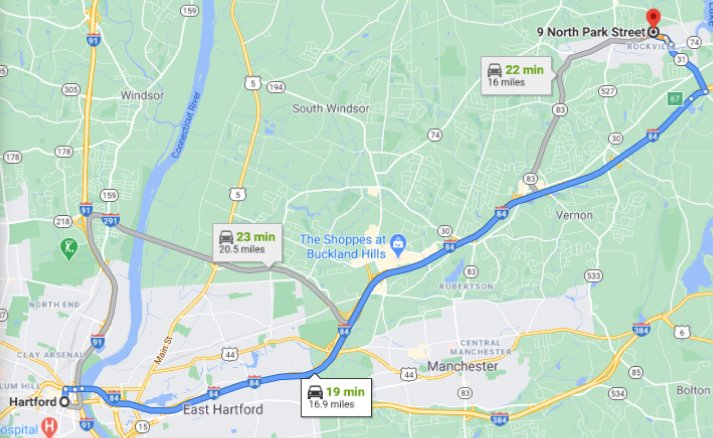
Rockville, a “village” in the town of Vernon, was less than a half-hour drive from downtown Hartford, even in rush hour. The prosperous part of the Hartford area was mainly on the west side of the Connecticut River. However, we would not have been likely to find anything comparable in the wealthy suburbs. If we did, our rent would probably have been a four-digit number.
Rockville at the turn of the century (i.e., around 1900) was a very prosperous mill town. Eight decades later it was still the location of many mansions that were once owned by the people who owned or managed the mills. One of the most impressive of the mansions was (and is) owned by the Rockville Lodge of Elks1. We rented the mansion’s Carriage House from the Elks. The address was 9 North Park St. North Park has one of the steepest slopes without switchbacks of any straight street that I have ever seen. I never tried to jog up it.
The Carriage House was a split-level dwelling. The stairway was in the middle. To the left of the front door pictured at left were levels 1L and 2L and the attic. To the right were the half cellar and levels 1R and 2R. The front door was on level 1R. Two rear doors were on level 1L.
- Behind the house was a courtyard that was approximately twenty feet deep and twice that in width. The left side of the courtyard was open. The other two sides were brick covered with ivy. I eventually planted a vegetable garden here.
- Level 1L contained the living room (which contained a fireplace), a dining area, pantry, and a kitchen on the far left. We used the massive barnboard shelves to serve as a divider between the dining area and the living area. A door led from the kitchen to a courtyard. A second door to the courtyard was on a landing at the foot of the stairs in the middle of the house. The only shower in the house was on that landing.
- The half-cellar was across from the back door in the middle of the house. It had a sink as well as the oil burner, water heater, and fuse box. Above it was level 1R. The only use we had for the cellar was during my abortive sauerkraut experiment several years later.
- Level 1R contained the main office. We placed the 5120 computer and printer and Sue’s credenza here. Eventually the office acquired additional equipment and furniture. There were windows on the front side and on the right. There were no windows on the courtyard side.
- The master bedroom took up the front half of Level 2L. The spare bedroom housed the waterbed and later became Sue’s office. That room and the bathroom (tub but no shower) were on the courtyard side.
- Level 2R was another bedroom with a sloped ceiling. We only used it for overnight visitors.
- Level 3L was an attic that could be reached from the bedroom on 2R by a door at the top of three or four stairs. It contained possessions of a previous resident. We did not use it.
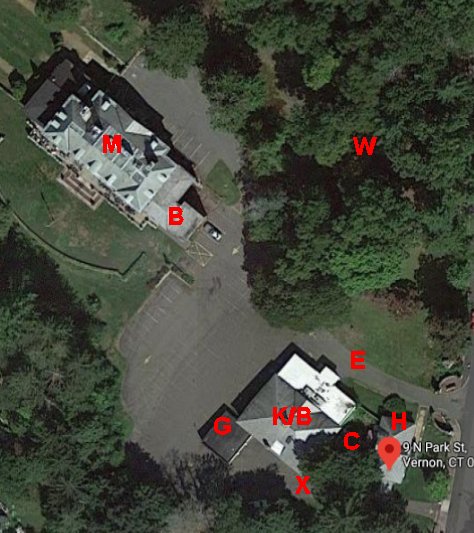
One-way driveways leading to the main house and the Elks Club bar were on either side of the Carriage House. The entrance could be seen from the main office on 1R and the exit from the kitchen on 1L.
The club had garage space for three cars. We were allowed to use one of them. The garage was forty or fifty feet from the kitchen door.
The grounds of the Elks club contained a fairly large wooded area. In the winter we scoured it for firewood. We could not afford to buy it at a store. We were quite poor throughout our first few years in Rockville. I think of these as the macaroni years.
The placement of the shower was inconvenient, but the only thing that I really hated about the Carriage House was the oil heat. It was horribly obsolete in 19812. I can hardly believe that I am still living in a residence with such an outmoded heating system forty years later.
When we moved in we only had one phone line. Eventually we bought a multi-line system.
Most of our friends from 1972-1975 were no longer in the Hartford area. We reconnected with Tom and Patti Corcoran, who were living in Wethersfield, the city just south of Hartford. By this time they had two kids, a boy named Brian and a girl named Casey.
We spent a lot of time with the Corcorans. They often fed us much better than we would have otherwise eaten. They came to visit us occasionally as well. I remember that I fixed country-style ribs and sauerkraut for them once. I don’t think that Casey tried any; in her early years she consumed only nectar, ambrosia, and the dew from daffodils. However, Brian was shocked when he took the first bite. “This is good!” he exclaimed with as much enthusiasm as he ever exhibited.
Sue registered TSI as a partnership at the town hall in Rockville. She was the president; I had no title. We never sat down and decided who was responsible for what part of the business. She arranged for her dad’s accounting firm to help her set up our books. Dan Marra3 of Mass and Hensley worked with her.
We hoped to be able to establish a relationship as the go-to programmers for IBM’s small business clients, but that did not work out too well at first. IBM went through periods when they loved the third-party programmers who specialized in IBM systems and periods when they were not eager to work with us. Early 1981 was one of the latter periods.
I tried to come up with ways to market Sue’s experience with IBM’s construction payroll system. Unfortunately, we had no access to any lists of IBM’s installations. Sue did some custom work for FH Chase Inc., a construction company south of Boston, and another firm in Boston. At FH Chase she worked with Victor Barrett4 and Mary Brassard. I also recently came upon an invoice from 1981 that Sue sent to Scott & Duncan, Inc. in Roxbury, MA, for a change to its payroll system. It was sent to the attention of Paul Williamson. I don’t remember anything about that company.
Sue sold one copy of Amanuensis, the word-processing program that I wrote, to Brown Insulation in Detroit, and I developed the retail inventory control and sales analysis system for Diamond Showcase. Sue also did some work for clients that she had contacted when we were in Detroit. They included CEI, based in Howell, MI, which owned a number of companies in various locations,
We were not making it. Sue and I were very frugal, but we were not reaching our “nut”. For one thing, the price of oil, which was at an all-time high, was killing us. I was just about at the point of throwing in the towel and looking for a job doing … I don’t know what. However, in July of 1981 IBM made an announcement that had a big effect on both our business and our personal lives. It was not the IBM PC; that came later. It was the System/23, also known as the Datamaster. At some IBM offices it was called the Databurger.
1. The Elks still own it in 2021.
2. I am embarrassed to say that forty years later we are still living in a house that is heated by oil. It makes me feel like a caveman.
3. Dan Marra lives in Colchester in 2021.
4. I am pretty sure that Victor Barrett works and lives in St. Charles, MO.

